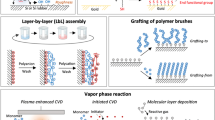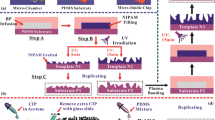Abstract
Surface wettability conversion with hydrophobins is important for its applications in biodevices. In this work, the application of a type I hydrophobin HGFI in surface wettability conversion on mica, glass, and poly(dimethylsiloxane) (PDMS) was investigated. X-ray photoelectron spectroscopy (XPS) and water-contact-angle (WCA) measurements indicated that HGFI modification could efficiently change the surface wettability. Data also showed that self-assembled HGFI had better stability than type II hydrophobin HFBI. Protein patterning and the following immunoassay illustrated that surface modification with HGFI should be a feasible strategy for biosensor device fabrication.

A hydrophobin HGFI has been applied into surface wettability conversion for protein immobilization





Similar content being viewed by others
References
Yam CM, Mayeux A, Milenkovic A, Cai CZ (2002) Langmuir 18:10274–10278
Hektor HJ, Scholtmeijer K (2005) Curr Opin Biotech 16:434–439
Wessels JGH, de Vries OMH, Asgeirsdottir SA, Schuren FHJ (1991) Plant Cell 3:793–799
Wosten HAB (2001) Annu Rev Microbiol 55:625–646
Wessels JGH (1994) Annu Rev Phytopathol 32:413–437
Scholtmeijer K, Janssen MI, Gerssen B, de Vocht ML, Leeuwen BM, von Kooten TG, Wosten HA, Wessels JG (2002) Appl Environ Microbiol 68:1367–1373
de Vocht ML, Reviakine I, Wosten HA, Brisson A, Wessels JG, Robillard GT (2000) J Biol Chem 275:28428–28432
Torkkeli M, Serimaa R, Ikkala O, Linder M (2002) Biophys J 83:2240–2247
Ritva S, Torkkeli M, Paananen A, Linder M, Kisko K, Knaapila M, Ikkala O, Vuorimaa E, Lemmetyinend H, Seecke O (2003) J Appl Crystallogr 36:499–502
de Vries OMH, Fekkes MP, Wosten HAB, Wessels JGH (1993) Arch Microbiol 159:330–335
Carpenter CE, Mueller RJ, Kazmierczak P, Zhang L, Villalon DK, van Alfen NK (1992) Mol Plant Microbe Interact 5:55–61
Sarno DM, Murphy AV, DiVirgilio ES, Jones WE, Ben RN (2003) Langmuir 19:4740–4744
Wang LK, Feng XZ, Hou S, Chan QL, Qin M (2006) Surface Interface Anal 38:44–50
Qin M, Hou S, Wang LK, Feng XZ, Wang R, Yang YL, Wang C, Liu L, Shao B, Qiao MQ (2007) Colloids and Surfaces B Biointerfaces 60:243–249
Park JH, Park KD, Bae YH (1999) Biomaterials 20:943–953
Marois Y, Sigot-Luizard MF, Guidoin R (1999) ASAIO J 45:272–280
Ertel SI, Ratner BD, Kaul A, Schway MB, Horbett TA (1994) J Biomed Mater Res 28:667–675
van-Kooten TG, Whitesides JF, von Recum AF (1998) J Biomed Mater Res 43:1–14
Interrante LV, Shen Q, Li J (2001) Macromolecules 34:1545–1547
Dahrouch M, Schemidt A, Leemans L, Linssen H, Goetz H (2003) Macromol Symp 199:147–162
Wessels JG (1997) Adv Microb Physiol 38:1–45
Genzer J, Efimenko K (2000) Science 290:2130–2133
Wilson DJ, Pond RC, Williams RL (2000) Interface Sci 8:389–399
Xia Y, Whitesides GM (1998) Angew Chem Int Ed Engl 37:550–575
Khorasani MT, Mirzadeh H, Sammes PG (1999) Radiat Phy Chem 55:685–689
Okaniwa M, Ohta Y (1997) J Polym Sci Part A Polym Chem 35:2607–2617
Yu L, Zhang B, Szilvay GR, Sun R, Janis J, Wang Z, Feng S, Xu H, Linder MB, Qiao M (2008) Microbiology 154:1677–1685
Kumar A, Whitesides GM (1993) Appl Phys Lett 63:2002–2004
Wenzel RN (1936) Ind Eng Chem 28:988–990
Wang R, Yang YL, Qin M, Wang LK, Yu L, Shao B, Qiao MQ, Wang C, Feng XZ (2007) Chem Mater 19:3227–3231
Acknowledgment
This work has been supported by the National Natural Science Foundation of China (Grant number: 90403140).
Author information
Authors and Affiliations
Corresponding author
Electronic supplementary information (ESI) available
Below is the link to the electronic supplementary material.
Rights and permissions
About this article
Cite this article
Hou, S., Li, X., Li, X. et al. Surface modification using a novel type I hydrophobin HGFI. Anal Bioanal Chem 394, 783–789 (2009). https://doi.org/10.1007/s00216-009-2776-y
Received:
Revised:
Accepted:
Published:
Issue Date:
DOI: https://doi.org/10.1007/s00216-009-2776-y




